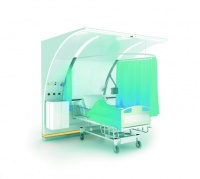Design for patient dignity
A re-think on the design of hospital equipment could enhance patient privacy and dignity.


’At the moment you either get moved around in a bed or a portering chair,’ he said. ’The problem is that a portering chair is the lowest common denominator of comfort. The other extreme is that people are being put in a bed when they don’t really need to be. Our design is a hybrid between the two. It allows you to recline at a 110° angle or lie in a neutral position, which according to recent research, significantly improves patient recovery time.’
PearsonLloyd has also developed a bay screen based on kite technology. The 1.5m divider is made up of fabric stretched over a series of lightweight carbon-fibre rods. Each screen is placed at a 45° angle so that patients are unable to see the beds opposite them when sitting or lying, but can still see and talk to the passing staff.
Lloyd explained that the idea behind the technology was to remove the need for curtains, as they remove both a patient’s connection with the hospital environment and control over privacy.
Register now to continue reading
Thanks for visiting The Engineer. You’ve now reached your monthly limit of premium content. Register for free to unlock unlimited access to all of our premium content, as well as the latest technology news, industry opinion and special reports.
Benefits of registering
-
In-depth insights and coverage of key emerging trends
-
Unrestricted access to special reports throughout the year
-
Daily technology news delivered straight to your inbox










Water Sector Talent Exodus Could Cripple The Sector
Maybe if things are essential for the running of a country and we want to pay a fair price we should be running these utilities on a not for profit...